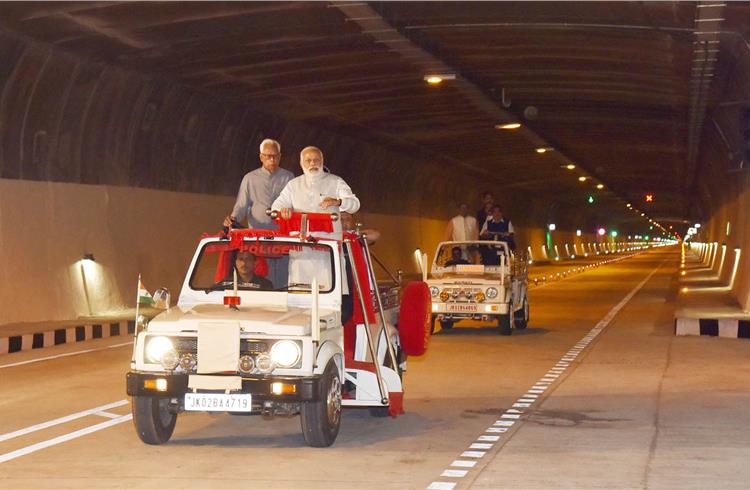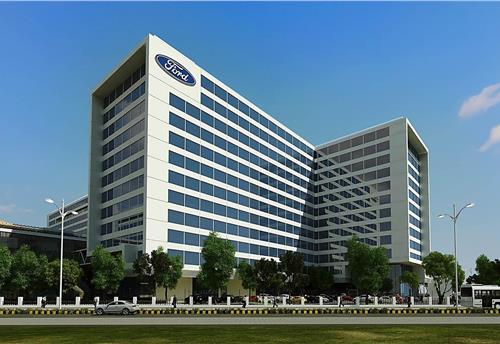India's longest highway tunnel in J&K is now open
The 9km-long, twin-tube, all-weather Chenani-Nashri tunnel between Udhampur and Ramban, which cuts travel time by two hours, is not only India’s longest highway tunnel but is also Asia’s longest bi-directional highway tunnel.
It's the beginning of a new erea of road connectivity in the state of Jammu & Kashmir. Yesterday, the all-new 9km-long Chenani-Nashri tunnel in Jammu & Kashmir, the longest highway tunnel in India, was officially inaugurated by prime minister Narendra Modi.
The twin-tube, all-weather tunnel between Udhampur and Ramban in Jammu & Kashmir is not only India’s longest highways tunnel but is also Asia’s longest bi-directional highways tunnel. Built at an elevation of 1,200 metres on one of the most difficult Himalayan terrain, the tunnel will cut the travel time between Jammu and Srinagar by two hours, bypassing about 41km of road length. It will also ensure an all-weather passage on a route that often sees heavy traffic jams and disruptions due to landslides, snow, sharp curves, breakdown of vehicles and accidents.
The tunnel, which was constructed at a cost of about Rs 3,720 crore, is part of the 286km-long four-laning of the Jammu-Srinagar National Highway. The structure consists of a 9km-long, two-laned main tunnel with a parallel escape tunnel of same length. The two tunnels are connected by 29 cross-passages at regular intervals along the entire length of the tunnel. These cross passages can be used for evacuation of vehicles and commuters in case of breakdown or any other emergency. There are two minor bridges on the south and north sides and four-lane approach roads with toll plazas on both ends of the tunnel. The maximum height permitted in the tunnel is 5 metres and for checking the height special sensors have been installed just before the toll points at both ends.
The tunnel has an efficient, transverse ventilation system. There are inlets bringing fresh air at 8-metre intervals and outlet for exhaust every 100 metres. There is also a fully-integrated control system with ventilation, communication, power supply, incident detection, SOS call box and firefighting. Fitted with intelligent traffic mechanism, the tunnel has fully automatic smart control and no human intervention will be required for its operations. The tunnel is also equipped with advanced scanners to ward off any security threat. Very few tunnels in the world have this kind of fully integrated tunnel control.
The project is also environment friendly. The time saving on the Jammu-Srinagar route will further result in fuel saving of approximately Rs 27 lakh per day. Besides, the construction of the tunnel has avoided large –scale deforestation.
The Chenani-Nashri tunnel will have a very positive impact on the state economy. In line with the Skill India initiative, the skill sets of local people were developed and improved, and they were engaged for construction of this tunnel. The project has provided employment to over 2,000 unskilled and skilled youth of Jammu and Kashmir as 94 percent of the work force was from the state. Around 600 to 900 people from across the country also worked on this project in three shifts over the past four years.

The Prime Minister, Narendra Modi inaugurating the 9.2km-long Chenani-Nashri Tunnel, in Jammu & Kashmir on April 2. Also seen are the governor of Jammu & Kashmir, NN Vohra; the Union Minister for Road Transport & Highways and Shipping, Nitin Gadkari; the chief minister of Jammu & Kashmir, Ms. Mehbooba Mufti and the minister of State for Development of North Eastern Region (I/C), Prime Minister’s Office, Personnel, Public Grievances & Pensions, Atomic Energy and Space, Dr. Jitendra Singh. (Photo: PIB)
Promoting tourism in J&K, new Zojila tunnel also being built
Speaking on the occasion, the prime minister said that the tunnel will not only reduce the distance between Jammu and Srinagar, but will also promote tourism in the valley, open up employment opportunities for the youth and give a boost to development in the state.
The Minister of Road Transport & Highways and Shipping, Nitin Gadkari said that Rs 7,000 crore will be invested in highways projects in Jammu & Kashmir in the next two years. He said a ring road will be built around Jammu at a cost of Rs 2,100 crore and another one around Srinagar at a cost of Rs 2,200 crore. Work on this project will start in the next three months, he said. Gadkari also revealed that informed that the Zojila tunnel is being built between Leh and Ladakh at a cost of Rs 6,000 crore. During 2016-17, Rs 1,019 crore was sanctioned for 72 projects in Jammu & Kashmir.
RELATED ARTICLES
Uniproducts India targets 15% growth till FY2027, eyes new EV OEMs for NVH parts
The Noida-headquartered company, which is a leading manufacturer of roof liners, floor carpets, sound insulation materia...
Ford to build more EV software capability at Chennai tech hub
Ford Business Solutions India, which currently employs 12,000 personnel set to add 3,000 more; Ford, which is known to b...
ASK Automotive to set up JV with Aisin to sell aftermarket parts for cars
Ask Automotive will have 51% of the equity of the joint venture to be set up with Aisin Asia (Thailand) Company and Aisi...





 By Autocar Pro News Desk
By Autocar Pro News Desk
 03 Apr 2017
03 Apr 2017
 9502 Views
9502 Views









